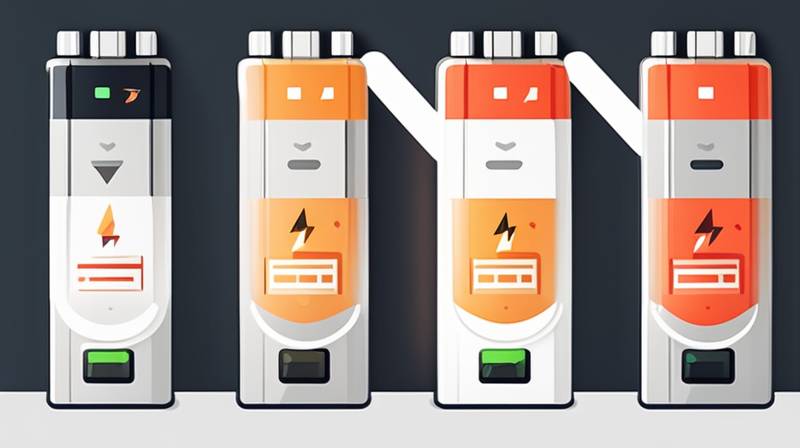
How many watts is the best for charging energy storage batteries?
- The optimal wattage for charging energy storage batteries depends on several factors, including battery type, capacity, and usage considerations Essential aspects include 1. Battery type, which determines charging efficiency, 2. Desired charging speed, impacting the watts required, 3. Efficiency loss, as higher wattage may cause increased heat generation, and 4. Power source compatibility, ensuring the charger can match the battery requirements. A deeper understanding of the battery’s specifications is crucial when determining the appropriate wattage.
UNDERSTANDING ENERGY STORAGE BATTERIES
Energy storage batteries have become indispensable in modern technology, serving applications ranging from portable electronics to renewable energy systems. These versatile units store electrical energy for later use, particularly from intermittent sources like solar and wind. Multiple battery chemistries exist, including lithium-ion, lead-acid, and nickel-metal hydride, with different charging characteristics and requirements.
Charging energy storage batteries efficiently is critical, as improper charging can lead to reduced performance, lifespan, or potential hazards. To ascertain the best wattage for charging, one must consider the battery’s voltage, ampere-hour (Ah) rating, and the manufacturer’s specifications. Each of these elements influences how quickly and safely the batteries can absorb power, transforming solar energy into stored electricity or recharging electric vehicles.
FACTORS INFLUENCING CHARGING WATTAGE
1. BATTERY TYPE
The classification of batteries serves as the foremost determinant of wattage requirements. Lithium-ion batteries have different charging protocols compared to lead-acid batteries, enabling them to accept higher current flows. Lithium-ion cells typically operate on a constant current/constant voltage (CC/CV) charging regime, which allows for increased initial wattage without damaging the unit. As a result, one can charge lithium-ion batteries in a fraction of the time needed for traditional lead-acid alternatives.
Conversely, lead-acid batteries necessitate more careful charging strategies, notably using lower wattage designs. The incorporation of a trickle-charge technique helps mitigate sulfation, a common issue leading to diminished capacity. Underestimating the wattage needed for lithium-ion could lead to inefficient charging; thus, understanding the specific type is a critical component in deciding the wattage.
2. CAPACITY AND CHARGING SPEED
Elaborating on the battery’s capacity is equally crucial. The amp-hour capacity indicates how much energy the battery can hold, directly impacting charging times. Higher-capacity batteries demand greater wattages to achieve swift charging, while lower-capacity contenders can utilize reduced wattage effectively.
Moreover, the speed at which the battery should be charged plays a pivotal role in determining wattage needs. Fast charging options often appeal to users, especially in energy-intensive applications. However, prioritizing charging speed may lead to increased temperatures, compromising battery health in the long term. Balancing wattage to facilitate rapid yet safe charging ensures longevity while maintaining user convenience.
3. EFFICIENCY LOSS AND HEAT GENERATION
Examining the relationship between wattage, efficiency, and heat generation is vital. Charging a battery at an elevated wattage can lead to efficiency losses, mainly due to internal resistance and heat. The better the conversion of electricity to chemical energy, the less waste heat is produced during the process. When charging at high wattages, excessive heat can degrade chemical compounds within the battery, resulting in shorter lifespans.
Calculating the optimal wattage requires understanding how much heat is generated under various charging scenarios. Proper thermal management strategies, such as utilizing cooling fans or heat sinks, mitigate potential damage. Ultimately, achieving a balance between sufficient wattage and efficiency ensures maximum charging capability with minimal detrimental effects.
4. POWER SOURCE COMPATIBILITY
Potential issues may arise from mismatching the power source to the battery’s wattage requirements. Using an incompatible charger can lead to insufficient power supply or excessive current flow, posing risks to battery safety. The inverter, converter, or charging station should have specifications aligning with the energy storage unit.
Considering the capabilities of the power source allows for reliable charging mechanisms. Renewable energy systems, for instance, might have variable outputs, reliant on solar irradiance or wind speed fluctuations. Opting for solar chargers compatible with the battery’s voltage and amp ratings helps in stable charging. In summary, ensuring synchrony between energy source and battery needs guarantees operational safety and efficiency.
FREQUENTLY ASKED QUESTIONS
WHAT IS THE IDEAL WATTAGE FOR LITHIUM-ION BATTERIES?
Lithium-ion batteries generally perform best between 0.5C to 1C charging rates, where ‘C’ signifies their capacity in Ah. Therefore, for a 100 Ah battery, this implies a charge rate of 50 to 100 watts. Rapid charging beyond this may risk heat generation and damage. Utilizing smart chargers that adapt to optimum wattage settings for specific battery conditions is advisable to maintain health and performance.
CAN TOO HIGH A WATTAGE DAMAGE THE BATTERY?
Indeed, excessive wattage may compromise battery health. High currents generate heat, accelerating chemical deterioration within the battery. It is vital to adhere to manufacturer specifications to ensure longevity, especially for lithium-ion varieties, which have protective systems to manage excessive charging. Ensuring compatibility with the designed wattage maintains efficiency.
HOW DOES TEMPERATURE AFFECT CHARGING WATTAGE REQUIREMENTS?
Temperature greatly influences charging efficiency and capacity. Higher temperatures can facilitate faster charging rates, yet they may also increase heat-related risks. Conversely, lower temperatures can lower capacity and charging efficiency. Therefore, it’s critical to charge batteries within their rated temperature ranges to mitigate risks induced by external thermal factors.
Considering the multifaceted attributes of energy storage batteries and their respective charging mechanisms elucidates the importance of tailored wattage. Factors such as battery type, capacity, efficiency losses, and compatibility with power sources play vital roles in discerning optimal charging methods to maximize lifespan and capability. Recognizing that no universal wattage exists serves as a reminder to thoroughly evaluate specific individual battery requirements and charging conditions before proceeding. Engaging with the manufacturer’s guidelines, coupled with an understanding of charging dynamics, enables a systematic approach toward effective charging practices. As advancements in battery technology continue to evolve, remaining informed on best practices in this arena remains critical. Embracing these considerations will allow for efficient charging processes, ushering in robust performance and long-term benefits for energy storage solutions.
Original article by NenPower, If reposted, please credit the source: https://nenpower.com/blog/how-many-watts-is-the-best-for-charging-energy-storage-batteries/


